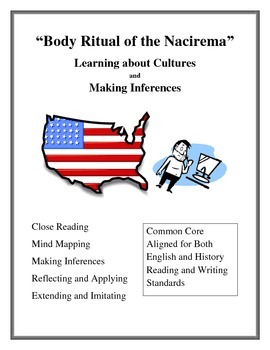"Body Ritual of the Nacirema": Learning about Cultures and Making Inferences
Teaching with Thompson
17 Followers
Grade Levels
9th - 12th, Higher Education
Resource Type
Standards
CCSSRI.9-10.1
CCSSRI.9-10.2
CCSSRI.9-10.4
CCSSRI.11-12.1
CCSSRI.11-12.2
Formats Included
- Zip
Teaching with Thompson
17 Followers
Description
“Body Ritual among the Nacirema” is a satirical scholarly article written by Horace Miner and published in a 1956 issue of American Archaeologist. In the article, Miner describes the odd habits of the Nacirema culture, specifically their body rituals. While many professionals (and students) who read this were/are fooled into thinking this is a real culture Miner had discovered, close reading and inferences reveal the Nacirema are actually Americans (Nacirema spelled backwards) and he’s describing our bathroom and medical behaviors.
In this product, students will:
Close Read
Mind Map
Make Inferences
Reflect and Apply
Extend and Imitate
This product is appropriate for high school history or English. I’ve used it in a general education 9th/10th grade history class studying culture and developing historical thinking skills. I’ve also used it with AP Language students studying satire. It works well at different ability and grade levels.
In this product, students will:
Close Read
Mind Map
Make Inferences
Reflect and Apply
Extend and Imitate
This product is appropriate for high school history or English. I’ve used it in a general education 9th/10th grade history class studying culture and developing historical thinking skills. I’ve also used it with AP Language students studying satire. It works well at different ability and grade levels.
Total Pages
Answer Key
Included
Teaching Duration
2 days
Last updated Aug 16th, 2014
Report this resource to TPT
Reported resources will be reviewed by our team. Report this resource to let us know if this resource violates TPT’s content guidelines.
Standards
to see state-specific standards (only available in the US).
CCSSRI.9-10.1
Cite strong and thorough textual evidence to support analysis of what the text says explicitly as well as inferences drawn from the text.
CCSSRI.9-10.2
Determine a central idea of a text and analyze its development over the course of the text, including how it emerges and is shaped and refined by specific details; provide an objective summary of the text.
CCSSRI.9-10.4
Determine the meaning of words and phrases as they are used in a text, including figurative, connotative, and technical meanings; analyze the cumulative impact of specific word choices on meaning and tone (e.g., how the language of a court opinion differs from that of a newspaper).
CCSSRI.11-12.1
Cite strong and thorough textual evidence to support analysis of what the text says explicitly as well as inferences drawn from the text, including determining where the text leaves matters uncertain.
CCSSRI.11-12.2
Determine two or more central ideas of a text and analyze their development over the course of the text, including how they interact and build on one another to provide a complex analysis; provide an objective summary of the text.


